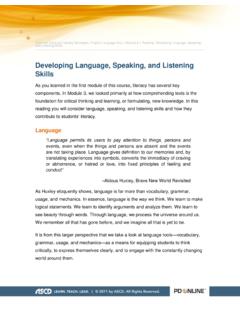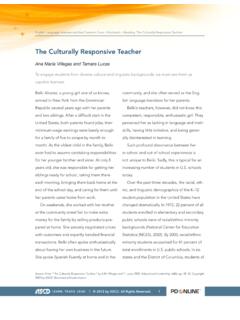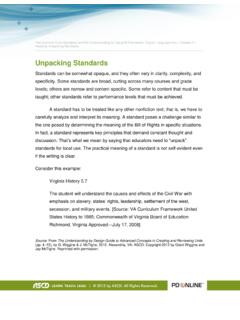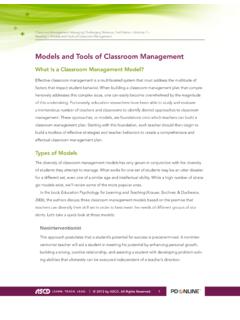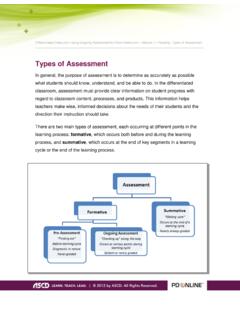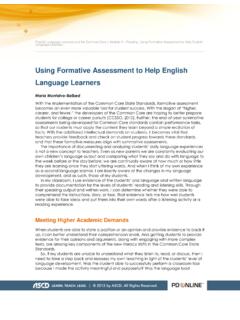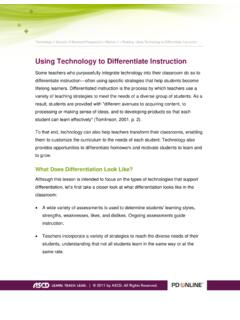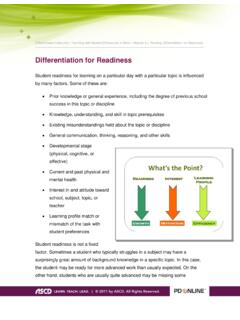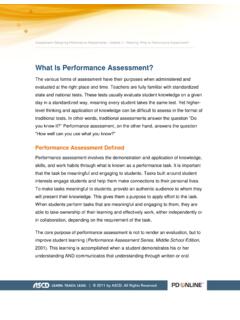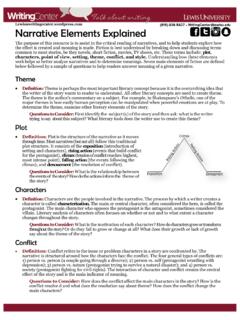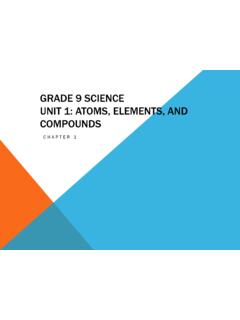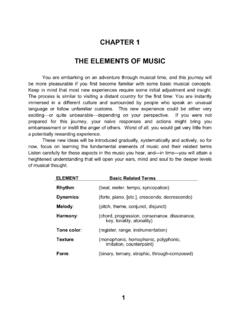Transcription of Key Elements of Differentiated Instruction
1 Differentiated Instruction : An Introduction > Module 4 > Reading: Key Elements of Differentiated Instruction _____ Key Elements of Differentiated Instruction Differentiated Instruction is based on modification of four Elements : content, process, product, and affect/learning environment. This modification is guided by the teacher s understanding of student needs the students readiness, interests, and learning profile. Let s take a closer look at some key vocabulary related to differentiation. What Can Teachers Differentiate?
2 Content Content means the knowledge, understanding, and skills (KUD) that students need to learn (Tomlinson & Imbeau, 2010). It s important to remember that these learning goals should nearly always remain the same for all students in the Differentiated classroom. What teachers can differentiate in terms of content is the methods that students use to access key content (p. 15). For example, students can acquire new information and ideas through reading independently or with a partner, reading a novel or listening to it on tape, doing online research or communicating with experts, participating in group demonstrations, or engaging in small-group Instruction (Tomlinson & Imbeau, 2010).
3 Or the teacher can present content in several ways in the classroom for example, by showing students images of concrete objects illustrating math concepts as a first step in teaching these abstract concepts. To address individual student needs, teachers also provide appropriate scaffolding when working with content by teaching prerequisite content to some students, allowing advanced students to move ahead of the class, or even changing the content for some students based on their individualized education programs (Tomlinson & Imbeau, 2010).
4 Differentiated Instruction : An Introduction > Module 4 > Reading: Key Elements of Differentiated Instruction Page | 2 _____ Process Tomlinson and Imbeau (2010) define process as how students come to understand and make sense of the content (p. 15). By differentiating process, they understand creating sense-making activities that help students own the content by allowing them to see how it makes sense, and realize how it is useful in the world outside the classroom (p. 15). Differentiating process is all about practice based on the content.
5 This involves students trying to figure things out, asking questions, and making mistakes. At this stage, says Carol Ann Tomlinson, Almost always students will need to work at different speeds, with different kinds of support, in different groupings, and in different modes. And that s a very important stage because this really is the point where learning happens with kids. Product Products are ways for students to demonstrate what they have come to know, understand, and be able to do after an extended period of learning (Tomlinson & Imbeau, 2010, p.)
6 15). According to Carol Ann Tomlinson, a synonym for a product is an authentic assessment, which gives teachers fertile ground for differentiation. Students can propose the way they d like to show us something, or we might offer them two choices with the notion that they can make a deal with us to do the third one, she says. Even multiple-choice or true/false tests can be Differentiated , says Tomlinson: I am seeing some districts do an interesting thing, especially where they have a lot of second language learners: They ll have the regular version of the test, and then one that one district called the plain-English version.
7 It s exactly the same thing, but they write it in a more streamlined way simpler vocabulary, more white space. Kids still have to understand and be able to work with the same things; they ve just made the format of it more accessible to them. Differentiated Instruction : An Introduction > Module 4 > Reading: Key Elements of Differentiated Instruction Page | 3 _____ Tools for High-Quality Differentiated Instruction : An ASCD Action Tool by Cindy Strickland (2007) includes the following suggestions for differentiating content, process, and product.
8 Content Process Product Leveled or topical readers Books on tape Highlighted text Varied topics for research Independent study options Interest centers Optional mini-lessons on a specific topic or skill Compacting the curriculum Online readings at varied levels of difficulty Demonstrations Opportunity to work alone, in pairs, or in small groups Group roles when in small groups Literature circle roles Varied journal prompts Choice of review activities Supportive technology Amount or kind of teacher help available Various types of graphic organizers and supporting documents (vocabulary, formulas, key dates, etc.)
9 Homework options ( Do this section if you need more practice or Do this section if you feel ready for a challenge ) Product options that respond to varied interests or learning profiles Varied timelines or check-in points Varied criteria for success ( from novice to professional) Varied audiences (in age, background knowledge, size, etc.) Varied roles in a performance assessment Some choice of questions on tests and quizzes Source: Strickland, C. (2007). Tools for high-quality Differentiated Instruction : An ASCD action tool.
10 Alexandria, VA: ASCD. Reprinted with permission. Affect/Learning Environment Affect/learning environment the effect of students emotions and feelings on their learning is another element of Differentiated Instruction . Our emotions and feelings, which are created by our past experiences and our reactions to current experiences, influence our self-concept, as well as motivation to learn and ability to collaborate. All these factors play a key role in the learning process. Differentiating student affect means modifying the learning environment to meet student emotional needs.
